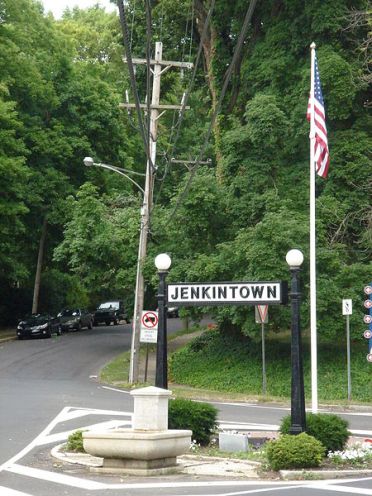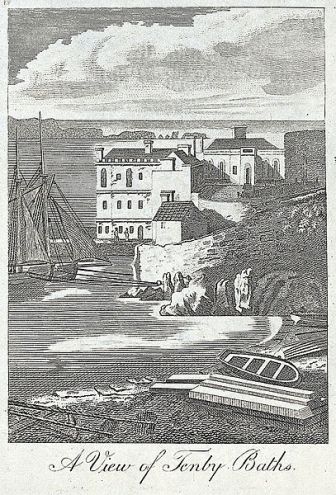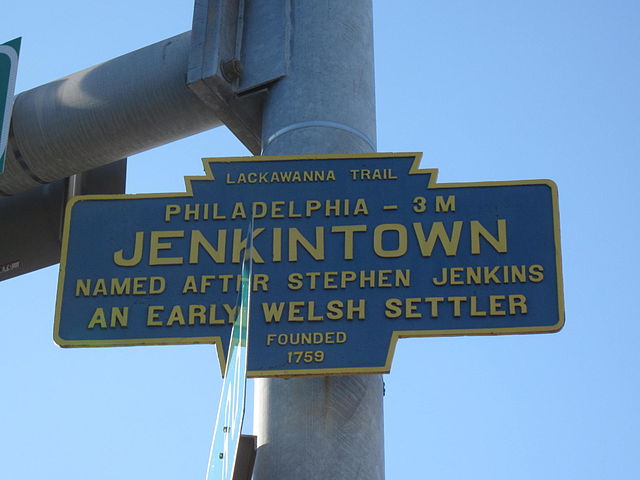Week 3: #52 Ancestors – Long Line
By Eilene Lyon
Two branches with the surname Jenkins converge on my tree at my 4th great-grandmother, Ann Widdifield Zane. She married David Jenkins, presumed from Wales, but not a Quaker like Ann. Next to nothing is known of his life or family, so this is a rather stubby stick.
Ann’s mother was Mary Jenkins, unrelated to David, and from a long line of Welsh Quakers. Thanks to excellent Society of Friends records, we can trace Mary’s ancestry at least back to William Jenkins and Elizabeth Griffith, my 8th great-grandparents.
But this is not a tale about a long line on my family pedigree. Rather, it’s about a long line on the map of Pennsylvania known as the Old York Road (originally just York Road). William and Elizabeth’s son, Stephen Jenkins, my 7th great-grandfather, had a hand in the alignment of this road, and is honored by a point along that route, called Jenkintown to this day.

Roads were a principal means that European colonists used to “civilize” the North American continent. The creation of transportation routes opened up trade between various cities and settlements.
The planning and building fell to committees of residents, based on petitions for new routes. What began as Indian footpaths evolved into bridle paths, then later widened to accommodate carriages and wagons.
Stephen Jenkins was one of 12 men appointed in 1711 to lay out a route from the Delaware River at what is now New Hope, Pennsylvania, to downtown old Philadelphia, after a petition for the road had been made to Governor Charles Gookin. This section covered roughly half the distance between Philadelphia and New York City, hence the name of the road. It was the first one established between these two cities.
It is not clear if the road went by Stephen Jenkins’s property because he arranged it that way, or if the petition for the road requested it, but likely the latter. Stephen’s son, Phineas, actually established Jenkintown, naming it for his father, but it appeared on maps as Jenkins’ Town as early as 1759.

According The York Road, Old and New (p. 25), “It was a laborious task to build 33 miles of road from the Delaware river to Philadelphia in a country thick with timber and thin of population. No dynamite extracted the stumps, and brave men toiled hard to destroy nature’s luxuriant growths that their wagons might pass where Indians and deer had made their home. The road stimulated settlement, and brought churches, schools and bridges.”
Jenkintown became a major crossroads, festooned with a variety of taverns. Many travelers, both north-south and east-west, eagerly watched the approach to this rest stop, where they could refresh themselves after bone-jarring carriage rides.

Stephen Jenkins was born November 14, 1680 in Tenby, Pembrokeshire, Wales. His father, William, for ₤20, bought 1000 acres in America from William Penn the following October. He may have emigrated shortly after, and upon arriving in Pennsylvania, William selected land in Haverford Township.
Elizabeth and two children – Margaret and Stephen – crossed the Atlantic in 1686 and joined William on the farm. Not long after, William sold that land and bought 473 acres from a man named Barnes in Abington Township.

There, William helped construct the Friend’s meeting house where his family worshiped for many years. Stephen grew up in Abington and married Abigail Pemberton on November 14, 1704. Abigail was the daughter of Phineas and Phebe (Harrison) Pemberton, immigrants from Lancashire, England.
Stephen and Abigail had seven children: four sons and three daughters. Stephen inherited the land in Abington when William died in 1712. He and his mother sold off most of it over the next eight years, but he retained a home on the east side of York Road. This home burned down in 1717 and the Jenkinses had to rely on the generosity of their fellow Society members to get through the winter.
There is still an existing home in Jenkintown that is reported to be the house constructed by Stephen Jenkins in 1718 (or 1736?). This house is believed to have been a stop on the Underground Railroad in later years. The 4,927 sq. ft. home went on the market for $1.2 million in 2013.
Stephen, Abigail and three of their sons, William, Phineas and Charles, continued to reside in Jenkintown. The fourth son, Stephen, Jr., my 6th great-grandfather, relocated to Philadelphia when he married in 1740, and appears to have been the black sheep of the family. But that is a story for another time.
Stephen remained a member of Abington Monthly Meeting for life, with one hiccup (a dispute over an invalid deed, for which he was condemned). Abigail was a Quaker minister. She died in 1750 and Stephen passed on in 1761. They are interred in the Abington Friends Cemetery in Jenkintown.
Feature image: Memorial sign for Stephen Jenkins in Jenkintown (Wikimedia Commons)
Stephen Jenkins on Ancestry.com
Sources:
https://en.wikipedia.org/wiki/Old_York_Road
https://www.findagrave.com/memorial/182389355
Ancestry.com. U.S. and Canada, Passenger and Immigration Lists Index, 1500s-1900s [database on-line]. Provo, UT, USA: Ancestry.com Operations, Inc, 2010.
Ann de B. Mears, 1890. The Old York Road and its Early Association of Biography and History 1670-1870. Harper and Brother, Philadelphia, p. 5.
Rev. S. F. Hotchkin, M. A., 1892. The York Road, Old and New. Binder and Kelly, Philadelphia.
William W. H. Davis, A. M. 1905. History of Bucks County, Pennsylvania from the Discovery of the Delaware to the Present Time. Second ed. Vol. 3. The Lewis Publishing Co., New York and Chicago, p. 534.
“William Jenkins One of the Early Jenkintown Settlers” The Times-Chronicle (Jenkintown, PA), March 5, 1936, pp. 1, 5.
Lloyd Manuscripts, Welsh Records from the Collection of the late Howard Williams Lloyd, 1912. The New Era Printing Company, Lancaster, PA, pp. 153-159.
John W. Gordon, 1911. Colonial & Revolutionary Families of Pennsylvania. p. 500.
Official Souvenir Booklet commemorating the 100th Anniversary of Jenkintown, Pennsylvania 1874-1974, pp. 4-6.
Thomas Allen Glenn, 1898. Genealogical Notes Relating to the families of Lloyd, Pemberton, Hutchinson, Hudson and Parke…Printed in Philadelphia, p. 45.

The Quaker lineage thing is awesome. But, part of me would like to see what would happen if someone took a dna test and it didn’t come up quite the way they expected
LikeLiked by 1 person
Oh, I’ve done that! I have to keep the details a bit hush-hush to avoid alarming some living persons.
This family line I feel pretty confident about. But I asked the local DAR guru about DNA and if the paper trail is solid, it doesn’t matter (not that I’m planning to join).
LikeLiked by 1 person
I got you. Dna testing really opens up a whole ball of wax. But it does bring into question the diabetes testing that the Amish are participating in. How is the testing effected because maybe someone’s father is not who they thought?
LikeLiked by 1 person
I’m not familiar with that project, but I can see it causing some distress.
LikeLiked by 1 person
We heard about it when we went to Dutch country pa about ten years ago. They’re doing a diabetes test because Amish birth records are so well documented they can start to specify specific genes for things. Of course, we heard about this pre dna resting boom
LikeLiked by 1 person
As someone who is eligible to be DAR and has been to one of their membership meetings, I applaud your decision to not pursue it. ‘Twas the whiniest bunch of self-important woman I’ve ever had the displeasure of spending an hour with.
LikeLiked by 1 person
Yes, I went to one meeting because there was a speaker talking about the Quakers. I am quite eligible to join but don’t see the point of it. I’ve never been much of a joiner!
LikeLiked by 1 person
Me neither. I went because my aunt, a social butterfly, thought I’d enjoy it. I politely bowed out, citing a busy work schedule, but deep down I knew those women were delusional. Weird experience.
LikeLiked by 1 person
Woo. That’s harsh!
LikeLiked by 1 person
Yep, they were harsh. I was expecting a group of history-minded kind women, joyful even. But not this bunch. Oh well, I’m better off as a free spirit.
LikeLiked by 1 person
I wonder how long it took to make that road without any heavy equipment…? I’m curious about the Abington Monthly Meeting. Is that a Quaker institution? What do you mean by condemned?
LikeLiked by 1 person
I am not certain how long, but I’ll see if I can find an answer. Yes, Quaker congregations are called meetings. They have monthly, quarterly, and yearly meetings, each one being larger groupings.
I think when he was condemned, he was asked to leave the congregation until he took measures to rectify the situation.
LikeLiked by 1 person
Interesting…it seems all religions have their punitive measures…(don’t worry I won’t get on my soapbox!)
LikeLiked by 1 person
The early Quakers were incredibly strict and incorrigible busy-bodies. Many attitudes we think of as “Puritan” are actually Quaker in origin. Serious prudes!! Of course, that has changed considerably.
LikeLiked by 1 person
It looks like it took as long as 60 years to build that section of road.
LikeLiked by 1 person
Wow, I wonder if there were two generations of workers!
LikeLiked by 1 person
Or even three!
LikeLiked by 1 person
I’m always amazed at how construction worked back in those times. Roadways and buildings alike, it must have been quite the task.
LikeLiked by 1 person
When I wrote about the National Road and read that all the rocks were chipped into appropriate gravel sizes by hand – I find it hard to comprehend! I can’t imagine how tedious and time-consuming such a task would be, nor how long a 10-foot stretch of road would take to build.
LikeLiked by 1 person
Yeah that is just crazy to think about.
We take it for granted, but I’m sure those who were responsible for paving and building did not.
LikeLiked by 1 person
How cool to have a town named after one of your ancestors! I was puzzled by the initials DAR in other comments and had to look it up. I get it now.
LikeLiked by 1 person
Yes, that would not be commonly known outside the U.S. – Daughters of the American Revolution, a lineage society. We love such things here, apparently. There are lineage societies for descendants of Mayflower passengers, witches, brewers, geographic regions and states, you name it!!
LikeLiked by 1 person
Interesting family history research! I also enjoyed the comments prompted by your post. In 1976, when my mother informed me I was eligible to join the DAR, I was absolutely horrified!
LikeLiked by 1 person
I wonder why so many of us find the DAR objectionable? A little too snooty?
LikeLiked by 1 person
I think so, yes. There is something disturbing about the notion that special status is bestowed upon one for accidents of birth one had nothing to do with.
LikeLiked by 1 person
Interesting point.
LikeLike
Eilene, you are such a wonderful historian! Hope all is well.
LikeLiked by 1 person
Thanks, Luanne, you are so kind! Doing ok here. How about you?
LikeLiked by 1 person
Other than all the anxiety about the trillions of dollars this is going to cost and if anybody that I care about gets sick I’m doing great.
LikeLiked by 1 person
I hear you…
LikeLiked by 1 person
Everyone on my paternal side comes from the exact area you are describing and were Quakers all. I’ll have to go back and see if we have any common ancestors!!
LikeLiked by 1 person
That would be interesting! My Jenkins people left Philadelphia in 1830. Other families from the area on my tree are Widdifield, Zane, and Bedford.
LikeLike
That’s pretty cool, having a town and road in your family — however far back it goes.
Quakers fascinate me. First, their name was a bit of a put-down and yet they kept it, and second, however prudish they were, they were fine with female ministers. Go Abigail!
LikeLiked by 1 person
Yes, the women fared better than in other denominations. They were educated and considered (somewhat) equal. Different, but not inferior. Same for the children.
LikeLiked by 1 person
I have an uncle (married to my mother’s sister) who is a Jenkins, though I get the impression it’s a fairly common surname. Interesting to learn about Jenkintown!
LikeLiked by 1 person
My particular line of Jenkins didn’t really pass on the surname (mostly female descendants who survived). Not that a connection is impossible. I’m not sure how common the name is.
LikeLike
Hi Eilene, I am catching up on your fascinating blog! I am always amazed at the family history that you have uncovered! I know it represents hours & years of dedicated time! This blog on the Jenkins was so interesting. I hadn’t realized we had more than one road builders in our genealogy! Maybe that’s why I have several engineers in my immediate family. The interest has come down thru many generations. Great stuff! Be safe & stay healthy!
LikeLiked by 1 person
Lovely to have you stop by, Bonnie! Hope you are all well up north. I still have such great memories of our reunion last summer. I’ve only scratched the surface of our Jenkins forebears. I think it will be fun to learn more about our Welsh connection.
LikeLike
Hi Eilene, Thank you for this article. I come from a family of Jenkins and wondered if we may be related? My grandfather was born and raised in and around Philadelphia, so it’s definitely probable. I’d love to connect with you to talk further about it. Have a great day!
LikeLike